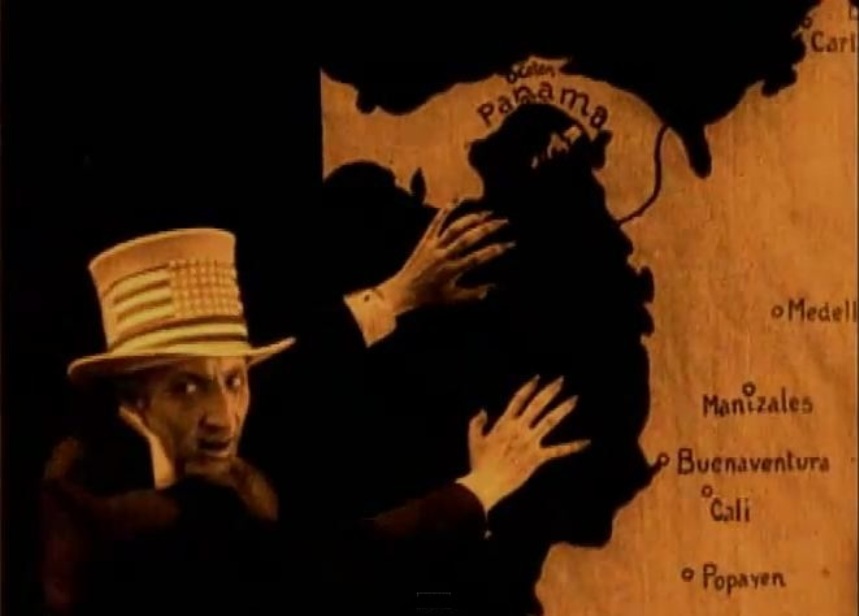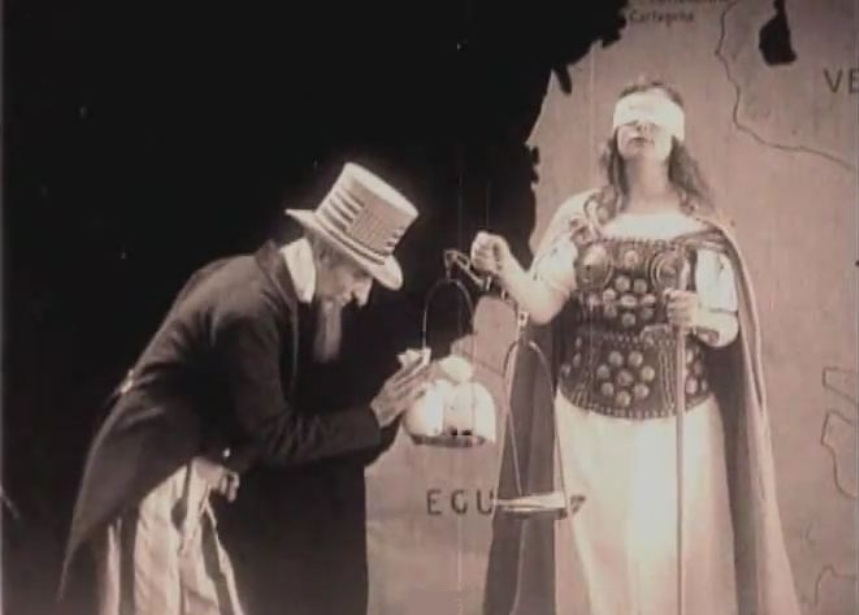Garras de Oro (1926) and the golden claws of American imperialism
Este é um
artigo sobre o filme mais enigmático do mundo. Ninguém sabe quem estava por
trás do filme “Garras de Oro”, de 1926: os atores não foram creditados, e a
equipe usou pseudônimos. O estúdio que produziu “Garras de Oro”, Cali Films,
nunca fez outro filme. Tanto mistério tem justificativa: o filme trata de uma
questão geopolítica que ainda estava fresca na mente dos colombianos, e o tom crítico
fez com que o filme fosse banidos nos EUA. “Garras de Oro” é, acima de tudo, um
filme que exemplifica perfeitamente a maneira como os EUA trataram a América
Latina no século XX.
This is an
article on the most enigmatic film in the world. Nobody knows who were the
minds behind 1926's “Garras de Oro”: the actors were uncredited, and the crew
worked under pseudonyms. The company that produced “Garras de Oro”, Cali Films,
never made another film. So much mystery is justified: the film is about a
polemic geopolitical question that was still fresh on the minds of Colombians,
and the critic tone of the film made it be banned in the US. “Garras de Oro”
is, above all, a film that perfectly exemplifies the way the US treated Latin
America in the 20th century.
“Garras de
Oro” é ao mesmo tempo uma denúncia e uma catarse. É a história de como, em
1903, a Colômbia perdeu boa parte de seu território graças à atuação dos EUA –
e este território ficou conhecido como Panamá. Na versão dramatizada dos fatos,
os EUA são chamados de “Yanquilandia”, e os cineastas não poderiam ser mais
claros sobre o alvo de suas críticas. Teddy Roosevelt continua sendo o
presidente da Yanquilandia, e para derrotar William Taft na eleição ele decide
roubar o Panamá da Colômbia.
“Garras de Oro” (Golden Claws) is at the same time a denunciation and a
catharsis. It is the story of how, in 1903, Colombia lost a good amount of its
territory thanks to the United States – and this territory became known as
Panama. In the dramatized version of the facts, the US is called “Yanquilandia”
(Yankee Land), and the filmmakers couldn’t be clearer about who they are
criticizing. Teddy Roosevelt remains president of Yanquilandia, and to beat William
Taft in the election he decides to steal Panama from Colombia.
Em Yanquilandia há uma cidade chamada Rasca-Cielos (Arranha-Céus) e o
jornal local, chamado de The World, está contra o plano de Roosevelt. Um homem
colombiano, señor González, mora em Rasca-Cielos e tem uma filha, Berta. Ela
está apaixonada por Paterson, um americano que pode ser repórter investigativo
do The World ou mesmo espião trabalhando para Roosevelt. Corrupção, poder,
espionagem e sexo são elementos importantes na disputa geopolítica pelo Panamá.
In Yanquilandia there is a city called Rasca-Cielos (Skyscrapers) and
the local newspaper, called The World, is against Roosevelt’s plan. A Colombian
man, señor González, lives in Rasca-Cielos and has a daughter, Berta. She is in
love with Paterson, an American man who can either be an investigative reporter
for The World or a spy working for Roosevelt. Corruption, power, espionage and
sex play important roles in the geopolitical dispute for Panama.
É basicamente este o enredo de “Garras de Oro”, mas o filme era,
originalmente, muito maior: hoje apenas 55 minutos sobrevivem, e temos só uma
versão truncada do que a película era para ser – a estimativa é de que 15% do
filme ainda está perdido. Novamente, há uma explicação pra isso: banido nos
EUA, o filme foi exibido na Colômbia em 1927 e depois esquecido por 60 anos,
quando foi parcialmente redescoberto e restaurado.
That’s basically it for “Garras de Oro”, but the film was originally
much more: today only 55 minutes survive, and we have only a truncated version
of what it was meant to be – it’s estimated that 15% of the film is still lost.
Again, there is an explanation for this: the film was banned in the US,
exhibited in Colombia in 1927 and then forgotten for 60 years, when it was
partially found and restored.
No final do século XIX e início do XX, os EUA basearam sua expansão
imperialista na Doutrina Monroe – definida pelo slogan “América para os
americanos”, que na realidade queria dizer “América para os norte-americanos”.
Isso significava que os EUA apoiariam a independência dos outros países
americanos de colonizadores europeus com o único intuito de influenciar a
economia e a política destes novos países. O imperialismo norte-americano era
diferente daquele praticado pelos países europeus: era uma colonização
ideológica, não territorial.
In the end of the 19th century and the beginning of the 20th, the US
based its imperialistic expansion on the Monroe Doctrine – defined by the
slogan “America for Americans”, that really meant “America for North
Americans”. This meant that the US would support the independence of other
American countries from their European colonizers with the sole purpose of
influencing these new countries in issues like economy and politics.
North-American imperialism was different from the one practiced by European
countries: it was ideological colonization, not territorial colonization.
 |
| "Cowboy" Teddy Roosevelt |
O Panamá tentou se tornar independente da Colômbia em muitas ocasiões, e
finalmente houve uma guerra em 1899, chamada de Guerra dos Mil Dias – naquela época,
a Colômbia era chamada de Nova Granada. Até então, os EUA haviam ajudado a
Colômbia / Nova Granada a manter o Panamá sob sua jurisdição. Em 1903 tudo
mudou, pois o Panamá declarou independência em três de novembro, e os EUA foram
o primeiro país a reconhecer esta independência – com a clara intenção de
explorar o novo país e colocá-lo sob suas asas ideológicas. De fato, logo após reconhecer
a independência do Panamá, os EUA ganharam o controle do canal transcontinental
que seria construído no novo país. O presidente norte-americano que apoiou a
independência do Panamá foi Teddy Roosevelt.
Panama tried to become independent from Colombia several times, and they
eventually started a war in 1899, called The War of a Thousand Days – at that
time, Colombia was called Nova Granada. Up until then, the US actually had
helped Colombia / Nova Granada to keep Panama under its jurisdiction. In 1903,
things changed, as Panama declared independence on November 3rd, and the US was
the first country to recognize its independence – with the clear intention of
exploring the new country and put it under its ideological wings. Indeed, right
after recognizing Panama’s independence, the US gained control of the
trans-continental canal that would be built in the new country. The US president
who supported the independency of Panama was Teddy Roosevelt.
Em inglês o filme ficou conhecido como “Alvorada de Justiça” por causa
de seu conteúdo catártico – um título bem mais inofensivo do que os títulos prévios
“A Vingança da Colômbia” e “A Morte Política de Teddy Roosevelt”. Os EUA
pagaram 25 milhões de dólares como indenização para a Colômbia pelo Panamá e
seu canal. No final de “Garras de Oro”, o Tio Sam deposita esta mesma quantia
na balança da Justiça personificada, mas os pratos da balança não se movem:
afinal, a justiça deveria ser cega e mostrar que a razão sempre esteve com os
colombianos.
In English the film became known as “Dawn of Justice” because of its
cathartic content – a title that is more inoffensive than the two working titles
“Colombia’s Revenge” and “The Political Death of Teddy Roosevelt”. The US paid
Colombia 25 million dollars to Colombia as indemnity for Panama and its canal.
In the very end of “Garras de Oro”, Uncle Sam deposits the same amount in Lady
Justice’s scale, but the scale does not move: after all, Justice should be
blind and should show that the Colombians were right to be bitter.
Você lembra que todos os envolvidos com o filme “Garras de Oro” ou não
receberam crédito ou usaram pseudônimos? Agora a história se complica. Há uma
teoria que diz que “Garras de Oro” sequer foi filmado na Colômbia, mas sim na
Itália. Mais recentemente, a identidade do diretor PP Jambrina, também fundador
da Cali Films, foi descoberta: ele era Alfonso Martínez Velasco, um político,
jornalista e empresário. As únicas outras pessoas creditadas em “Garras de Oro”
são dois diretores de fotografia com sobrenomes italianos, e a atriz italiana
Lucia Zanussi pode ter sido parte do elenco. Assim como o nome dos outros
membros do elenco e o restante da trama, é possível que nunca saibamos a
verdade sobre o local de filmagem.
Do you remember that everyone involved in the making of “Garras de Oro”
was either uncredited or used pseudonyms? Now the plot thickens. A theory says
that “Garras de Oro” may not have been shot in Colombia at all, but in Italy.
More recently, the identity of director PP Jambrina, also founder of Cali
Films, was discovered: he was Alfonso Martínez Velasco, politician, journalist
and entrepreneur. The only other credited people in “Garras de Oro” were two
cinematographers with Italian last names, and Italian actress Lucia Zanussi is
rumored to be part of the cast. Just like the name of other cast members and
the rest of the plot, the place it was shot is something we might never know
for sure.
Durante o século XX, os EUA usaram o cinema como arma imperialista: por
todo o mundo, e na América Latina em especial, o cinema norte-americano
dominava e disseminava os valores norte-americanos. Hoje, este fenômeno é
irreversível, mas felizmente os EUA e Hollywood se abriram para as estrelas
latinas. Agora em Hollywood temos alguns colombianos fazendo sucesso, como
Sofía Vergara, Isabella Gomez e John Leguizamo. A animosidade causada por “Garras
de Oro” há quase 100 anos parece ter sido deixada no passado, mas temos sorte
porque parte do filme sobreviveu para contar uma história real sob uma
perspectiva única: do ponto de vista dos colonizados.
As the 20th century progressed, the US used cinema as a huge imperialist
weapon: all over the world, and in Latin America in special, US cinema
dominated and disseminated American values. Today, this phenomenon is
irreversible, but fortunately the US and Hollywood became more open to Latin
stars. Now in Hollywood we have a few Colombians thriving, like Sofía Vergara,
Isabella Gomez and John Leguizamo. The animosity caused by “Garras de Oro”
nearly 100 years ago seems to have been left in the past, but we’re lucky that
part of the film survives to tell a real story in such a unique perspective:
from the point of view of the colonized people.
This is my
contribution to the Hollywood’s Hispanic Heritage blogathon, hosted by Aurora
at Once Upon a Screen.









2 comments:
What an amazing story! The politics of a century ago have come alive through your telling us of those anonymous filmmakers and their passion.
This is an absolutely fascinating topic and discussion, Le. Thank you so much for submitting this to the blogathon. I learned loads!!
Aurora
Post a Comment